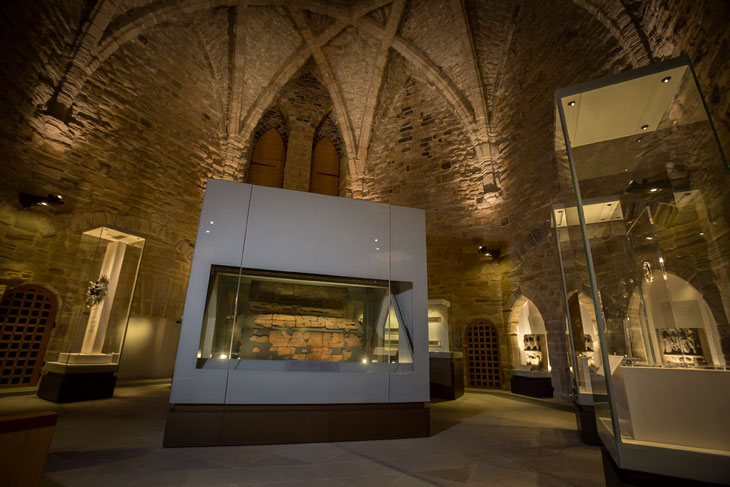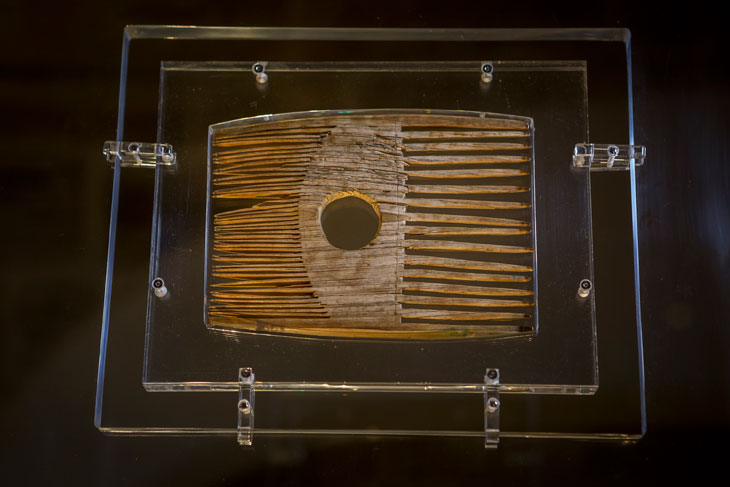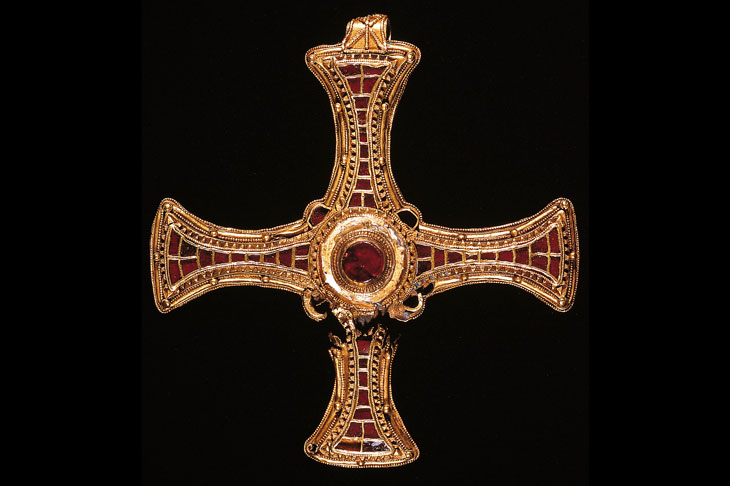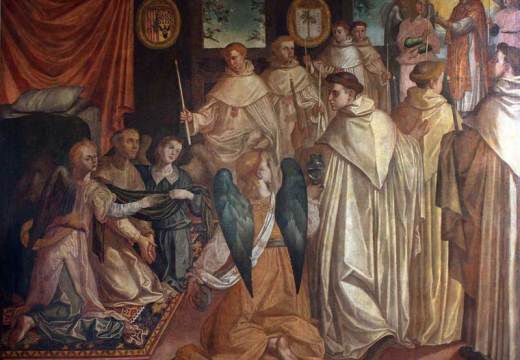At the heart of ‘Open Treasure’ is a display of things previously located inside of the coffin of Durham’s premier saint, Cuthbert. The exhibition includes several of the most remarkable medieval objects to be seen anywhere, beautifully arranged in the newly refurbished medieval Great Kitchen of Durham Cathedral. Surrounding displays constitute a larger exhibition of material, including a fascinating collection of Anglo-Saxon sculpture, but it is the treasures believed to have been buried with Cuthbert which stand out as uniquely important.
The exhibition is the end result of a Heritage Lottery Funded project focused on the visitor experience, and the grant money has allowed Durham to reveal and present parts of the building which were inaccessible to visitors before. This in itself is a triumph. Spaces such as the monks’ dormitory or the kitchen reveal aspects of religious life in a cathedral which add domesticity to the feeling of awe invoked by a visit to the monumental church next door. What is striking about this new exhibition of the Cuthbert material is its presentation, which allows the visitor to get up close to most of the objects and to see them in the round. This enhances the visitor’s ability to examine the objects and adds greatly to the pleasure of looking.

© Durham Cathedral
On 17 May 1827 – in circumstances devoid of medieval pomp and ceremony – a grave at Durham Cathedral believed to be St Cuthbert’s was opened. During the Middle Ages his shrine was a destination for international pilgrimage, but it had long since been destroyed. Inside the grave the excavators found a wooden coffin, an ivory comb, a wooden portable altar with a silver covering, vestments, embroideries, and famously a gold pectoral cross with garnet inlay. Somewhat utilitarian sounding in nature, these objects were far from mundanely functional. Several have no parallel and all are exceptional. Their existence allows us to catch a glimpse of a material past all but lost. The actions of those present in 1827 brought these treasures up from the ground; however, this was not the first time the shrine had been opened, and ‘Open Treasure’ at Durham Cathedral is only the latest instance of a long fascination with Cuthbert’s tomb and its contents.
At the time of his death in 687, Cuthbert had risen to become bishop of Lindisfarne. He was originally buried inside of the priory church, but due to frequent Viking incursions on the northern shores of England, the monks were forced to retrieve his body and move on. After a short peripatetic existence they variously settled in Chester-le-Street and Ripon, eventually selecting Durham as a permanent home for the saint. As extraordinary as it was to move an entire religious institution in a time of conflict, the added difficulties of transporting the coffin of a previous bishop must have been immense. Durham provided a permanent base for Cuthbert but he was not left alone for long. After the Conquest, the church at Durham was rebuilt and in 1104 Cuthbert’s coffin was opened once again, this time for its relocation into a new shrine. At the time, a small 8th-century book known as the St Cuthbert Gospel was removed; it is now at the British Library.

© Durham Cathedral
Bodies were important in the medieval past, as they are still for many cultures across the world. They carry the authority of the individual, and this was often recognised in the chosen site for their resting place, which absorbed and transmitted their corporeal power through pilgrimage. In medieval England it was the bodies of saints which marked places of religious and political power: St William at York, St Edward at Westminster, St Thomas Becket at Canterbury, St Hugh at Lincoln and St Cuthbert at Durham. The power of these bodies and the institutions which housed them sharply divided Europe in the 16th century as the Reformation sent shockwaves throughout Christendom. Although his shrine did not survive, Cuthbert’s body and the astonishing objects associated with it did.
Alongside the ruins of Lindisfarne and its titular Gospel book at the British Library, the objects associated with Cuthbert’s shrine are rightly famous as some of the most important treasures of the Anglo-Saxon past. Their new display in ‘Open Treasure’ shows that the story of Cuthbert and the objects associated with his shrine have an enormous capacity to capture our imaginations, much as they did for so many who came before.
The Treasures of St Cuthbert are on permanent display in the Great Kitchen as part of ‘Open Treasure’ at Durham Cathedral.
Unlimited access from just $16 every 3 months
Subscribe to get unlimited and exclusive access to the top art stories, interviews and exhibition reviews.














![Masterpiece [Re]discovery 2022. Photo: Ben Fisher Photography, courtesy of Masterpiece London](http://www.apollo-magazine.com/wp-content/uploads/2022/07/MPL2022_4263.jpg)
It’s time for the government of London to return to its rightful home